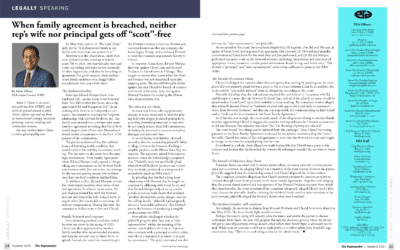Over the past several years, it has be-come increasingly difficult to determine what types of evidence are needed for an employee or ex-employee to have a viable discrimination claim. A recent decision of the Court of Appeals for the Seventh Circuit, which covers Illinois, Wisconsin and Indiana, provides some clarity as to what is necessary and makes it easier for employees to prevail in a discrimination case.
Federal courts traditionally identified two different methods by which employees could prove employment discrimination claims. A defendant’s rare admission that it engaged in discrimination or other “smoking gun” proof is classified as direct evidence. Consider the experienced employee passed over for a promotion whose supervisor states: “your retirement is in sight, and we’re hoping to find someone who will stay with the company for years.”
More commonly, where evidence of overt discrimination is lacking, a plaintiff claiming discrimination must use indirect evidence. This is typically done by asserting that a “similarly situated” employee outside a protected category has been treated more favorably than the employee claiming discrimination. For example, indirect evidence of a termination motivated by discrimination may be shown when the same supervisor who fires a black employee for four incidents of tardiness retains a white employee with five tardies.
Courts have criticized the direct/indirect evidence dichotomy as simplistic, but on a somewhat inconsistent basis. Some evidence, such as suspicious timing, ambiguous statements, or discrimination against other employees in the same protected class, cannot be pigeonholed either as direct or indirect evidence, although courts recognize that such evidence can prove discrimination. Therefore, trial courts have been directed to look at the different types of evidence presented by an employee to determine whether, in the aggregate, it comprises a “convincing mosaic” of discrimination.
In a stinging decision handed down on August 19, 2016, the Seventh Circuit emphatically rejected the focus on the “rat’s nest of” direct/indirect tests and convincing mosaics, noting they have “complicated and sidetracked employment-discrimination litigation for years.”
The decision came in Ortiz v. Werner Enterprises, Inc., arising from Henry Ortiz’s termination by a shipping company. Ortiz alleged he was fired due to his Mexican ethnicity, pointing to slurs directed at him throughout his tenure. Werner countered he falsified business records, although Ortiz asserted that he was merely correcting records improperly blaming him for losses.
The appellate court reversed the lower court’s dismissal of Ortiz’s claims for failing to paint “a convincing mosaic of discrimination,” rejecting talk of mosaics and direct/indirect methods of proof. The appropriate inquiry in all further employment cases were simplified: “Whether a reasonable juror could conclude that Ortiz would have kept his job if he had a different ethnicity, and everything else had remained the same.”
Finding Ortiz had presented sufficient evidence to convince a reasonable juror that Werner “didn’t much like Hispanics,” and that he was fired for using techniques tolerated when practiced by other brokers, the appellate court held he was entitled to a trial on his allegations of discrimination. The employment discrimination focus must be on whether the evidence shows that “the plaintiff’s race, ethnicity, sex, religion, or other proscribed factor caused the discharge or other adverse employment action.”
The Ortiz ruling opens many new avenues for disgruntled employees to prove adverse actions were motivated by discrimination. Employers should take immediate notice and make sure that any decision to discipline an employee is both well-documented and supported by legitimate business reasons.



